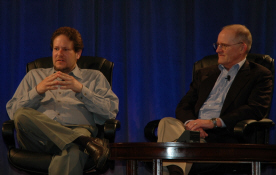The future of the enterprise and grids

Remember all the talk about outsourcing and offshoring, building virtual corporations in the same way Hollywood assembles disparate groups to make a movie? That’s become passé now, or at least more of a background to the larger issue of globalization. Enterprises are shifting their focus to have footprints around the world under one umbrella of accountability, according to Bill Janeway, vice chairman of Warburg Pincus, who hosted a discussion at the Future in Review conference with AMD CTO Fred Weber and Dick Lampman, senior vice president of research at Hewlett-Packard. The Internet is enabling easier communications across geographies and time zones, but that doesn’t mean that face-to-face meetings will fade away. "IT makes it possible to work globally, but in no way makes it easy," said Weber. "Telepresence is great, but the people you go out to dinner with will forge a deeper relationship." Lampman chimed in that the Internet provides a "set of power tools to build on top of human relationships and trust."

AMD CTO Fred Weber (left) and HP SVP Research Dick Lampman
An IT global community, both internally and extending to partners and outsourcers, creates more organizational complexity. "The complication of global business is as big as the opportunities it creates," Weber said. One of the dangers is bringing every decision to a central authority, which slows down decision making. Technology can help speed decision flow, but not if the organizational structure is bottlenecked.
In the area of new models for transacting, HP is investigating auction models and dynamic pricing, both for selling to customers and filling its own supply chain, Lampman said.
John Thompson, CEO, Marketing Sciences, hosted a panel of experts on the future of grid computing. Panelists included Wolfgang Gentzsch, managing director, MCNC; Wayne Clark, architect, Intelligent Network Services, Cisco; Larry Smarr, Harry E. Gruber Professor, Department of Computer Science and Engineering, UCSD, and director, California Institute for Telecommunications and Information Technology. Panelists highlighted the merging of grid protocols and Web services and alliances among various standards bodies and trade groups, such as the Global Grid Forum and the Globus Alliance.
Most of the high performance grid deployments are in Europe and come from academia. "It seems like a silent revolution, but we've seen this at least two or three times before and it ends up with a major change," Smarr said. He should know. Smarr was director of the National Center for Supercomputing Applications (NCSA) when in 1992 Marc Andreesen and colleagues developed the first Web browser--NCSA Mosaic.